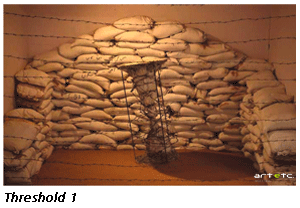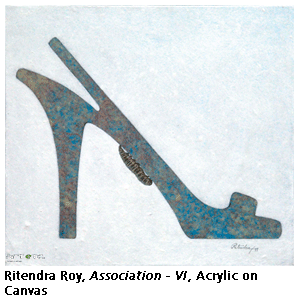- Publisher's Note
- Editorial
- Guerrilla Girls: The Masked Culture Jammers of the Art World
- Creating for Change: Creative Transformations in Willie Bester’s Art
- Radioactivists -The Mass Protest Through the Lens
- Broot Force
- Reza Aramesh: Action X, Denouncing!
- Revisiting Art Against Terrorism
- Outlining the Language of Dissent
- In the Summer of 1947
- Mapping the Conscience...
- 40s and Now: The Legacy of Protest in the Art of Bengal
- Two Poems
- The 'Best' Beast
- May 1968
- Transgressive Art as a Form of Protest
- Protest Art in China
- Provoke and Provoked: Ai Weiwei
- Personalities and Protest Art
- Occupy, Decolonize, Liberate, Unoccupy: Day 187
- Art Cries Out: The Website and Implications of Protest Art Across the World
- Reflections in the Magic Mirror: Andy Warhol and the American Dream
- Helmut Herzfeld: Photomontage Speaking the Language of Protests!
- When Protest Erupts into Imagery
- Ramkinkar Baij: An Indian Modernist from Bengal Revisited
- Searching and Finding Newer Frontiers
- Violence-Double Spread: From Private to the Public to the 'Life Systems'
- The Virasat-e-Khalsa: An Experiential Space
- Emile Gallé and Art Nouveau Glass
- Lekha Poddar: The Lady of the Arts
- CrossOver: Indo-Bangladesh Artists' Residency & Exhibition
- Interpreting Tagore
- Fu Baoshi Retrospective at The Metropolitan Museum of Art
- Random Strokes
- Sense and Sensibility
- Dragons Versus Snow Leopards
- What Happened and What's Forthcoming
- Art Events Kolkata, February – March 2012
- Mumbai Art Sighting
- Art Bengaluru
- Delhi Dias
- Musings from Chennai
- Preview, March, 2012 – April, 2012
- In the News, March 2012
- Cover
ART news & views
Delhi Dias
Issue No: 27 Month: 4 Year: 2012
by Lopamudra Pakira
Hulchul
 Art in the age of mechanical reproduction has not only lost its character by being an image, it has, as an experience, become almost inaccessible to people. And instead of being accessible as artistic phenomena, instead of being an agent to amplify and celebrate sensuous experience, it is getting increasingly commoditized: it is becoming a vain object for the bored rich, a status marker, a collectible item to adorn corporate receptions and opulent drawing rooms. The artists and lovers of art, the two most important agents of arts production and consumption, are becoming marginal and powerless entities the artists are finding it more and more difficult to find galleries, and lovers of art are getting more and more alienated from the cold, impersonal nature of art galleries and art shows.
Art in the age of mechanical reproduction has not only lost its character by being an image, it has, as an experience, become almost inaccessible to people. And instead of being accessible as artistic phenomena, instead of being an agent to amplify and celebrate sensuous experience, it is getting increasingly commoditized: it is becoming a vain object for the bored rich, a status marker, a collectible item to adorn corporate receptions and opulent drawing rooms. The artists and lovers of art, the two most important agents of arts production and consumption, are becoming marginal and powerless entities the artists are finding it more and more difficult to find galleries, and lovers of art are getting more and more alienated from the cold, impersonal nature of art galleries and art shows.
To take art to where it belongs, among people and allow art to happen; to allow art to achieve full significance and meaning in the warmth of human intimacy and intelligent consciousness; to allow art to speak to the needs and concerns of people and to make a true community possible, every art lover gathered together at Mandi House Circle to create some 'hulchul' on the 2nd March.
In Various Territorie
 Shrapnel in latitude 28, opened on the 3rd March consisting of 3 recent bodies of work by Veer Munshi: a painting-based environment, The Chamber, a suite of photographs titled Pandit Houses and a two-channel video work, Leaves Like Hands of Flame. It has previously been exhibited in Mumbai and in Kolkata. Ranjit Hoskote, curator of the exhibition, writes: “In Shrapnel Munshi adopts the elegist's chosen forms: the memorial and the archive. These forms allow him to shift the focus from the image to the conditions that make the image possible, or even inevitable.”The Chamber, which has evolved organically from Munshi's paintings about the distortion of everyday life through civil strife, terror and endemic violence, simulates a conflict zone. Entering it, we find every movement timed with an explosion, every moment sharpened by the agitator's call to arms.
Shrapnel in latitude 28, opened on the 3rd March consisting of 3 recent bodies of work by Veer Munshi: a painting-based environment, The Chamber, a suite of photographs titled Pandit Houses and a two-channel video work, Leaves Like Hands of Flame. It has previously been exhibited in Mumbai and in Kolkata. Ranjit Hoskote, curator of the exhibition, writes: “In Shrapnel Munshi adopts the elegist's chosen forms: the memorial and the archive. These forms allow him to shift the focus from the image to the conditions that make the image possible, or even inevitable.”The Chamber, which has evolved organically from Munshi's paintings about the distortion of everyday life through civil strife, terror and endemic violence, simulates a conflict zone. Entering it, we find every movement timed with an explosion, every moment sharpened by the agitator's call to arms.
And in the ongoing photographic archive that Munshi has built up, Pandit Houses, he presents, for the first time, an invisible side of the Kashmir story: the homes abandoned by Pandits fleeing into exile, which have fallen into ruin, been reclaimed for use by neighbours or requisitioned by the armed forces. Leaves Like Hands of Flame (running time 5 min 3 sec) is a two-channel video meditation. Its title comes from a line in a poem by Ranjit Hoskote, which speaks of the chinar. Through one channel, which remains deceptively static, Munshi runs an animation sequence that tracks the gradual burning-down of a grand old mansion from his Pandit Houses archive. Through the second channel, the artist records his journey by boat and on foot through an embattled Kashmiri winter landscape of fallen leaves, swirling water and falling snow.
Existing Antiquities
 There is a beautiful installation of a small town situated at an isolated location in Israel. It is far from the crowded, raucous cities. People are happy and living peacefully. The installation has a flowing silhouette. Another piece, with a pair of army shoes, speaks volumes about Israeli freedom and history. Yet one more fabulous installation of Nimrod stands tall on a mountain made of bricks and soil. Nimrod was a powerful hunter. He once ruled over the ancient kingdoms of Babylon, Erech, Akkad and Calneh, in Shinar. His name appears thrice in the Bible. People still wonder if he was a godly or vicious king.
There is a beautiful installation of a small town situated at an isolated location in Israel. It is far from the crowded, raucous cities. People are happy and living peacefully. The installation has a flowing silhouette. Another piece, with a pair of army shoes, speaks volumes about Israeli freedom and history. Yet one more fabulous installation of Nimrod stands tall on a mountain made of bricks and soil. Nimrod was a powerful hunter. He once ruled over the ancient kingdoms of Babylon, Erech, Akkad and Calneh, in Shinar. His name appears thrice in the Bible. People still wonder if he was a godly or vicious king.
Delhi-based Israeli artist Achia Anzi displayed numerous such installations at Gallery Threshold. They speak volume about the country's extensive Israeli history and culture. Anzi remarked, “No matter where you live, your heart belongs to the place you were born. This is my debut show. All my art has been inspired by Israeli traditions and culture.” He informed that all the installation mainly deal used metal wires and loads of plaster and relates with life of Jews in exile and tribes of Zion. He focused to make people aware about Israeli history, and the crises that the state had faced. Anzi also reflected on war, pointing to another installation. He explained, “It depicts the lives of Israelis during war, which I find similar to imprisonment. Cement bags indicate people, dry deserted land without water and anything to eat. There is no electricity, people struggle to stay alive.” To get the effect to be simple but be loudly expressive, the artist avoids all forms of colour. The exhibition was on till March 30th.
Feel At Home
 Desire to enter into the world beyond the painting, to try and penetrate the silence that engulfs the vast spaces in canvases? Then one must take a glimpse of the Home, a solo exhibition by Ritendra Roy at Gallerie Ganesha which opened on the 22nd March. Like Alice, the viewer seems to fall into his painting, trying to navigate the magical places/ spaces that lead towards a doorway at the far end. Beyond the doorway lie secrets; concealed, mysterious and beckoning; compelling in their illusory elusiveness. In Roy's oeuvre on display, one can see three main thematic streams; architectonic, narrative and lyrical, however, they are united by treatment, texture and colour. Roy states “Home is a concept of order and identity. It is an attitude of being an association with regard to a behavioural response. To be at home is to belong and be oriented in space within a huge void of public landscape. This includes the surrounding environment consisting of different elements that I have or had an emotional attachment. The various facets of these elements have acted as a referential framework for my paintings. My subjective concern has been the exploration of different paradigms of the 'interior' and 'exterior' landscape and bringing them into a visual dialogue.”
Desire to enter into the world beyond the painting, to try and penetrate the silence that engulfs the vast spaces in canvases? Then one must take a glimpse of the Home, a solo exhibition by Ritendra Roy at Gallerie Ganesha which opened on the 22nd March. Like Alice, the viewer seems to fall into his painting, trying to navigate the magical places/ spaces that lead towards a doorway at the far end. Beyond the doorway lie secrets; concealed, mysterious and beckoning; compelling in their illusory elusiveness. In Roy's oeuvre on display, one can see three main thematic streams; architectonic, narrative and lyrical, however, they are united by treatment, texture and colour. Roy states “Home is a concept of order and identity. It is an attitude of being an association with regard to a behavioural response. To be at home is to belong and be oriented in space within a huge void of public landscape. This includes the surrounding environment consisting of different elements that I have or had an emotional attachment. The various facets of these elements have acted as a referential framework for my paintings. My subjective concern has been the exploration of different paradigms of the 'interior' and 'exterior' landscape and bringing them into a visual dialogue.”
The built environment, suggestive of interior and facades of architectural endeavors, can be seen at times interacting sometimes with the natural spaces. The works are marked by repetitive patterns that form symmetries of space, balancing the various elements in the composition. There are pathways, stairs going up and coming down, pyramidal halls and walls dividing the spaces, suggestive perhaps of freedom, ether and eternity. The show is on till the 25th of April.